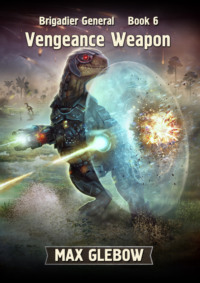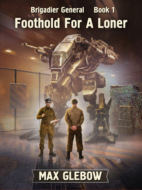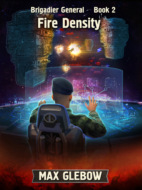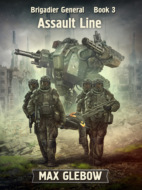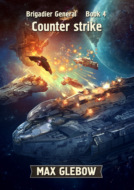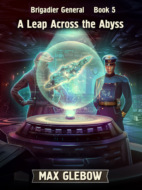Kitabı oku: «Vengeance Weapon», sayfa 3
“The fortresses combine their camouflage fields into a common veil through which our scanners are unable to penetrate,” reported Yoon Gao, “I’m afraid that when it comes to the assault, the force fields will also form a single spherical shield over the planet.”
“If things are so bad, then why did some captive toads agree to work for us in exchange for promises of high positions in the occupation administration after our victory? So they don’t really believe in the indestructibility of this defense,” answered Fulton with a doubt in his voice, scrutinizing the image on the screen.
“We’ll know everything soon enough, Officers, Sirs,” I replied as I watched the «Invisibles» and aircraft carriers approach the torpedo launching line, “If the toads are able to surprise us with something, it will happen now.”
A wave of ripples went through the image on the projection screen. For a fraction of a second it blurred and then became clear again. The eight orbital fortresses closest to the ships approaching the opening fire line were enveloped in purple protuberances, and after ten seconds a blob of energy resembling a small but brightly flaring artificial sun formed above each of them. The envelopes of the just-born luminaries, reaching an unbearable brightness, burst and fell in themselves, collapsing into dots, and from these points to the seven destroyers and the Black Dragon rushed lightnings of absolute darkness, slightly illuminated in some places by a dark gray, making them distinguishable against the blackness of space.
The destroyers disappeared in bright flashes. No debris, no internal explosions, nothing. Just a spherical wave of scattering photons. Denver was a little luckier, although I couldn’t really call it luck. The battleship’s protective field flared up and instantly went out. It was able to absorb some of the energy of the enemy salvo, but not all of it. The volley of toads could not completely destroy this Black Dragon-class battleship, but what was left of it could no longer be called a warship. A pathetic melted fragment barely a quarter of its original size remained of the once formidable fighting machine.
“Break off the attack! «Invisibles» and aircraft carriers, withdraw immediately from the battle!”
My order was too late. The drone torpedo carriers had already fired a salvo and were now laying down on a course to diverge from the planet, and nearly nine thousand torpedoes were rushing toward the enemy orbital fortresses, which had just destroyed eight of our ships, including the newest battleship, whose superiority over the enemy we had all pinned such hopes on, with the first shot.
The enemy managed to fire 13 more times, and now other orbital fortresses were firing. Apparently, it took a long time to recharge that unknown weapon. We lost two quarg aircraft carriers and 11 «Invisibles», and the rest of the ships managed to escape. And then a wave of our torpedoes hit three orbital fortresses.
Yoon Gao’s fears were not in vain. The network of fortresses really formed a single wall of energy protection. Perhaps if the torpedoes had been equipped with old-style warheads, few would have reached their targets. But now the torpedo was not required to make direct contact with the target. The disposable plasma cannon sent its charge to the target from a very respectable distance, so that anti-aircraft guns and short-range missiles largely lost their effectiveness against torpedoes, which simply did not approach the target at a dangerous distance.
For 15 seconds, the shield that covered the orbital fortresses was ablaze with continuous bursts of plasma blasts, and when the last flashes of fire went out, it was clear that the enemy defense was not absolute after all. Two of the three fortresses we attacked survived. At any rate, their markings remained in place, and we could not assess the damage the enemy had received as the camouflage fields were in the way. But the third fortress was gone. Its shapeless wreckage and fragments of armor and internal structures were pulled out of orbit and partly scattered in the surrounding space, and some fell to the planet, trapped by its gravity.
It was in grim silence that we watched the outcome of the battle. The exchange of a Black Dragon and two dozen other ships for one enemy orbital fortress looked depressing. We could console ourselves with the fact that we were cautious enough not to try to approach the planet with the whole fleet.
“The second search team found the enemy transport ring,” Yoon Gao reported over the hypercomms, and a new marker flashed on the tactical projection.
The toads had positioned a hypergate in the asteroid belt beyond the orbit of the seventh planet. They had not evacuated the portal personnel and seemed seriously intent on protecting such a valuable facility, now that the enemy had discovered it.
But here the situation turned out to be quite different. The hyperportal of toads was guarded in an unprecedented way for a autonomous space structure. Ten asteroids, put into circular orbits, orbited slowly around it. The enemy had turned them into a kind of orbital fortress, and I feared that it was not modern «frogs» who did this, but their distant ancestors back when the portal was built, so we could expect about the same kind of nastiness from these defenses that we already had the dubious pleasure of encountering near the fourth planet. And besides, three cruisers covered the hypergate, though, judging by some of the details of their construction, they were modern ships, far inferior to those built by the toads’ ancestors.
“The asteroids are close enough to each other, most likely, the protective field will be unified here, too,” Admiral Fulton suggested, “but, by all appearances, our fleet is quite capable of overcoming this defense.”
I agreed with the Chief of Staff in his assessment of the situation, but we were all getting very tired of losses. This endless war has taken the lives of the best, the most energetic and dedicated people and our allies, and lately I have seen it as my primary goal to stop this massacre. Yes, wars are not won without casualties, but the main question is what the commander sees as his main goal – a victory or saving the lives of his soldiers. Almost always this choice results in a compromise, but each time the compromise is left to the conscience of the commander ordering the attack.
“Commander Klitch,” I called the commander of the remaining aircraft carriers, “Are your ships capable to move automatically to the torpedo launching range, fire a salvo, and then proceed to a predetermined rendezvous point?”
“Yes, Commander, Sir, we can program our computers to perform such a task,” replied the quarg with a doubt in his voice, “but in this case the ships will not be able to react to changes in the combat situation and will carry out the order regardless of the actions of the enemy. It is impossible to control them remotely, this was done on purpose to prevent the enemy Electronic Warfare systems from intercepting the control in combat.”
“Commander Klitch, in the next five minutes you will receive the attack vector, as well as the coordinates of the torpedo launching point and the assembly point. Leave two aircraft carriers in reserve and order the crews of the others to prepare to evacuate to your ships that participated in the previous attack. They don’t have any torpedoes left anyway, so they’ll work as transports.”
“Yes, Admiral, Sir,” the quarg did not object or ask any clarifying questions. Apparently, the tradition of unquestioning obedience to a commander was deeply ingrained in his society. But I didn’t abuse it and explained my order.
“The enemy’s mobile forces are extremely weak. The toads will not be able to mount an active defense and do anything that might make it necessary to change the original order. As the previous attack has shown, your aircraft carriers, Commander Klitch, will be priority targets for the enemy’s new weapons in the coming battle. I see no point in sending your crews to certain death. It’s better to risk just the ships, even if we lose them all.”
I paused for a moment, giving the quarg a chance to respond, but Klitch only tilted his head slightly, and I continued with my mission statement to the fleet.
I ordered 56 of the 70 «Invisibles» not yet involved in the battle, to have their crews removed, and to prepare to attack in automatic mode, along with 17 quarg aircraft carriers. I divided the rest of the fleet into two equal groups. In the initial phase of the operation, they were to move with the ships left without crews, but long before they reached the torpedo launching line both groups were instructed to perform a flank maneuver in the ecliptic plane and simulate an attack on the toads’ portal from opposite sides. Except that I forbade them to go closer than two torpedo launch distances, at least until the results of the main torpedo strike are clear.
When planning the attack, we had to put too many unknowns into the calculations. Not only did we not know the physical principles upon which the enemy’s previously unknown weapons were based, we had no idea how long it would take to recharge before it could fire another salvo. But combat reconnaissance is designed precisely to get the missing information directly in combat, forcing the enemy to reveal their defense system and fire capabilities.
Half an hour later, during which time the disposition had not changed at all, I gave an order to begin the attack. The «Invisibles», rearranged in battle order, moved in an extended line ahead of our squadron. The quarg aircraft carriers stayed behind for now, as I wanted to provoke the toads to spend the charge of their ancient weapons on the «Invisibles» in order to give the aircraft carriers a chance to shoot off in peace. The death of even one of these huge ships would significantly reduce the density of our salvo.
“Squadron separation point,” Fulton reported, looking at the tactical projection.
The ships changed course, and two groups of six Black Dragons, five destroyers, seven «Invisibles» and one aircraft carrier split apart, beginning to outflank the enemy on both sides, and 17 aircraft carriers and 56 «Invisibles» continued to move directly at the enemy, who had prepared to defend.
The toads were faced with a difficult choice. The enemy certainly could not destroy with their monstrous cannons all the ships going into a frontal attack before they launched their torpedoes. 56 ‘Invisibles’ were carrying nearly 3,500 torpedoes, and to let them fire off in peace would be a very reckless act for the enemy, with very unpleasant consequences. But if the toads started firing at them and thereby reducing the density of the first salvo, then it would be unclear with what to meet even more dangerous quarg aircraft carriers later, which were capable of unleashing a several times more massive wave of torpedoes on the heads of the portal defenders.
I couldn’t call what the toad commander did anything other than a gesture of despair. Seeing that the formation of «Invisibles» and aircraft carriers was approaching his fortifications without artillery ships escorting them, the enemy commander ordered his three cruisers to come out to meet them. However, this decision was somewhat belated. While our fleet moved in a single formation, the toads hesitated to use their ships for a counterattack, and when the flank groups finally separated, the «Invisibles» were not so far from the torpedo launching line.
Nevertheless, the toads’ cruisers played their part, and they managed to do even more than they could according my estimation. 14 of our ships disappeared in the brightest flashes of explosions of their own unspent ammunition. The programs embedded in the «Invisibles» computers had some flexibility, and in addition to hitting the main targets the computer could spend up to ten percent of the ammunition, attacking any enemy ships within its range. Not only that, it was obliged to attack any such target, which is what happened when the toads’ ships appeared. But torpedoes move much slower in space than projectiles, and the toads managed to fire several volleys before they were hit by the dense wave of lethal messengers that almost instantly knocked down their protective fields and turned their ships into melted wreckage.
And after that, the toads put their ancestral weapons into action. All ten asteroids enveloped themselves in the purple protuberances we have seen before. Unlike the orbital fortresses, two artificial suns formed next to each of them, in a few moments they collapsed inside themselves and emitted lightning bolts of dark energy toward the approaching «Invisibles». 17 brightest flashes brought our losses in this attack to 31 ships. But there were 20 shots!
“Senior Analyst, report! Why didn’t the enemy three guns go off?”
“Apparently, some kind of malfunction or technical failure,” replied the young colonel in charge of the analytical service of the headquarters, and displayed on the projection screen in slow motion the picture recorded by the probe nearest to the scene. “Note, the destruction of the energy clot here was not the same as in the case of successful shots. The pseudo-star created by the toads’ weapons simply exploded instead of collapsing, scorching the asteroid’s surface. According to our estimates, the enemy fortifications would have sustained significant damage in the blast.”
“An ancient weapon that had been idle for a long time without proper maintenance could well explode in the hands of its not too competent owners,” Admiral Fulton nodded thoughtfully.
Meanwhile the battle continued, and 25 survived «Invisibles» finally reached the opening fire line. Of course, their salvo was severely weakened. The reason for this was not only combat losses, but also the expenditure of part of the ammunition to repel the counterattack of enemy cruisers. As a result, a little over a thousand torpedoes went to the targets instead of three and a half thousand. Given the quality of enemy scanners and guidance systems, this volley was hardly capable of inflicting serious damage on the enemy.
The asteroids, turned into space fortresses by the toads, met the wave of our torpedoes with a dense wall of barrage fire from the major caliber guns, and a minute later they were joined by numerous plasma cannons. In fact, the toads successfully repulsed the first attack, only single torpedoes broke through to their targets, and the plasma clots of their disposable cannons failed to cause any significant detriment to the enemy’s protective fields. But the quarg aircraft carriers, which had not yet had their say in the battle, were already on the attack course, and the nerves of the portal defenders failed.
Fire protuberances flashed again around the asteroids, but they looked much less bright and saturated than in the first salvo, that destroyed 17 «Invisibles». Apparently the toads didn’t have enough time to properly recharge the energy stores that powered their ancient weapons, but they couldn’t afford to wait any longer. The 17 artificial stars that had begun to form above the asteroid surface were also not impressive in size, and they burst into flames somewhat reluctantly. Now we were getting valuable information about the enemy weapons. We observed its operation in extreme mode, at the limit of its capabilities. This alone justified all the casualties we suffered during the reconnaissance raid.
And then something happened that apparently the toads themselves did not expect. I don’t know if they had ever tested their most dangerous weapon under such conditions before. Possibly not. Otherwise, they probably wouldn’t have taken such a risk. Seven of the 17 pseudo-suns successfully collapsed inside themselves, and emitted the familiar lightning bolts of darkness towards the aircraft carriers, but the others… They also tried to fire, but apparently a certain energy threshold had to be crossed for a successful salvo, and they did not have time to gain the necessary energy. The ten man-made stars collapsed jerkily in several moves, each time throwing black and gray lightning bolts in random directions. Most of them went into space without any visible effect, but the asteroids took about a dozen hits, and a pair of lightning bolts struck the hyperportal, ripping huge chunks out of the ancient structure and breaking the massive ring into two unequal pieces.
At the points of impact, the surface of the asteroids swelled with explosions that threw giant fountains of steam, glowing dust, and incandescent debris into space. The camouflage field, which had previously been unified, was torn to shreds, and now only four of the ten asteroids were still blurry spots on the tactical projection. The rest of the toads’ fortresses have taken shape and revealed to our scanners a picture of total destruction.
In fact, the task could be considered completed, and if I had the chance, I would have stopped the attack of the quarg ships that were in the torpedo launching line, and would have asked the toads to surrender. But there was not the slightest possibility of contacting the computers switched to offline mode, and the ten surviving aircraft carriers fired a full torpedo salvo. A sluggish barrage fire of completely demoralized enemy could not change anything in the current perilous situation for the toads, and in seven minutes, four thousand plasma blasts ripped into the enemy fortress protective fields, wiping them out in a split second and turning the enemy fortifications into an erupting volcano.
Commander Klitch and his quargs, I think, were pleased with the spectacle, and in some ways I could understand it, but I myself took no pleasure in contemplating this local Armageddon. Samples of ancient toads’ weaponry should have been captured intact and not wiped into powder and vaporized in streams of raging plasma. And, most importantly, we had the opportunity to do it. The toads would surely give up, where would they go? But who knew…
We spent two more days capturing the autonomous space objects. Taking advantage of the total absence of enemy warships in the system, I ordered our own transport ring to be deployed not far from the destroyed toads’ portal and contacted Admiral Nelson.
“Well, Igor Yakovlevich, congratulations on your first success as commander of the Allied fleet,” Nelson smiled having listened to my report, “Do you need any assistance?”
“We have a mountain of trophies here, Mr Minister,” I smiled back at Nelson, “There are a lot of shipyards and factories abandoned by the toads in the system. They prepared some of them to be blown up and even managed to destroy some of them, but we’ve managed to capture a lot of them almost intact. Right now our boarding robots are taking control of the most interesting autonomous space objects, but we clearly don’t have enough forces for that as that’s not why we flew here after all. Could you send General of the Army Barrington to help me? I think the operation has now entered the stage where his talents are indispensable. I wouldn’t stay here too long. Who knows what the toads are capable of? They now sit quietly on their planets under a dense network of orbital fortresses, but this isn’t their only star system, they can counterstrike, and I only have 14 Black Dragons and nearly empty drone torpedo carriers.”
General Barrington had not arrived alone. Following the cruiser that had brought the rear chief to us, there was an endless stream of huge evacuation transports, the same ones built for transporting prisoners from the Kappa Ceti system. It seemed that our genius of logistics was seriously determined to take out of the enemy star system everything his grasping hands could reach.
“Commander, Sir,” Barrington, after reviewing the list of the captured objects, addressed to me with a slight smile, “I’m afraid your squadron will have to stay here for at least six days. It would be just criminal to leave such trophies here or to destroy them.”
I started thinking. Such a delay was not part of my plan. It seems that a large fleet of toads could not appear in the system. If they had it, they would have brought it here through the portal a long time ago and not let us take over their space with impunity. But the risk was still quite high. We had already encountered one surprise that had cost us quite a bit. Who knows how many more of these trump cards the enemy has up his sleeve? But Barrington was also understandable. The Federation was desperate for new technologies, and here they were practically lying around to pick up.
“All right, General of the Army, Sir, you will have six days, but I need your men to deploy three more transport rings in different parts of the system. In the event of a sudden change in the situation, this will allow transports to quickly evacuate through the nearest portal. I will send you the coordinates of the gate installation points.”
“I’ll give the order,” Barrington nodded and plunged into the process of organizing a professional looting of the enemy industrial infrastructure.
Ücretsiz ön izlemeyi tamamladınız.
